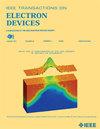Low-Resistance and Thermally Stable Ohmic Contacts on n-GeSn Using Ni and Ti Metallization
IF 2.9
2区 工程技术
Q2 ENGINEERING, ELECTRICAL & ELECTRONIC
引用次数: 0
Abstract
The development of suitable contacts for n-doped GeSn is a critical challenge to fully realize the potential of GeSn-based devices. Here, we have used transfer length method (TLM) measurements to investigate the contact properties of n-doped GeSn films with 6% of Sn after different types of metallization (with Ni, Ni0.9Pt0.1, and Ti). We also quantified the impact of different surface precleaning methods on contact formation. We successfully achieved ohmic contacts for all metallizations and measured contact resistivities as low as用Ni和Ti金属化制备n-GeSn上的低电阻和热稳定欧姆触点
开发合适的n掺杂gsn触点是充分发挥gsn基器件潜力的关键挑战。在这里,我们使用转移长度法(TLM)测量了不同类型的金属化(Ni, Ni0.9Pt0.1和Ti)后,含6% Sn的n掺杂GeSn膜的接触性能。我们还量化了不同表面预清洗方法对接触形成的影响。我们成功地实现了所有金属化的欧姆接触,并测量了低至$10^{-{5}}~\Omega \cdot $ cm2的接触电阻率。ni基触点的稳定性高达$350~^{\circ}$ C,而Ti基触点表现出优异的热稳定性(至少在触点形成退火的时间尺度上),保持性能高达$400~^{\circ}$ C。虽然Ti已被用于接触p掺杂的GeSn薄膜,但这项工作代表了其对n掺杂薄膜适用性的首次探索。
本文章由计算机程序翻译,如有差异,请以英文原文为准。
求助全文
约1分钟内获得全文
求助全文
来源期刊

IEEE Transactions on Electron Devices
工程技术-工程:电子与电气
CiteScore
5.80
自引率
16.10%
发文量
937
审稿时长
3.8 months
期刊介绍:
IEEE Transactions on Electron Devices publishes original and significant contributions relating to the theory, modeling, design, performance and reliability of electron and ion integrated circuit devices and interconnects, involving insulators, metals, organic materials, micro-plasmas, semiconductors, quantum-effect structures, vacuum devices, and emerging materials with applications in bioelectronics, biomedical electronics, computation, communications, displays, microelectromechanics, imaging, micro-actuators, nanoelectronics, optoelectronics, photovoltaics, power ICs and micro-sensors. Tutorial and review papers on these subjects are also published and occasional special issues appear to present a collection of papers which treat particular areas in more depth and breadth.
 求助内容:
求助内容: 应助结果提醒方式:
应助结果提醒方式:


